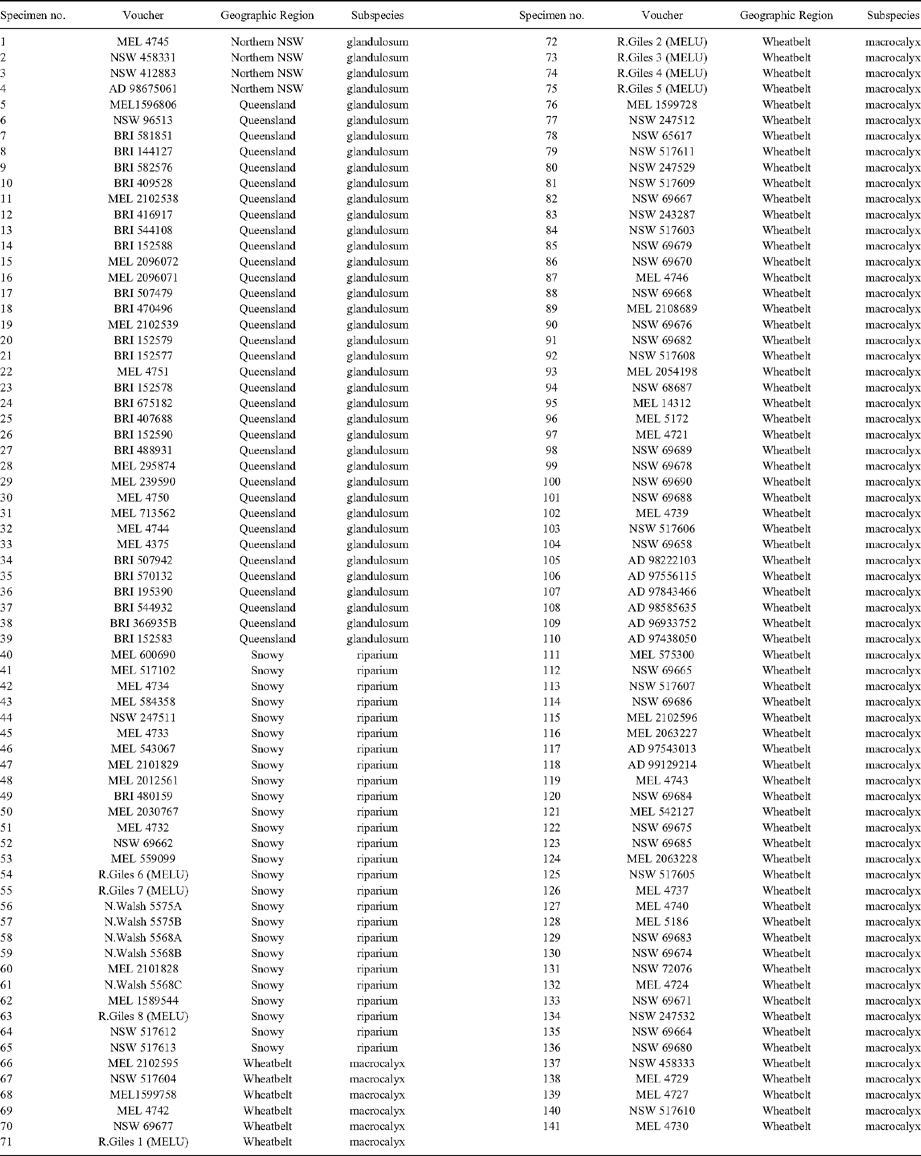Variation in Phebalium glandulosum subsp. glandulosum: morphometric and anatomical evidence (Rutaceae)
Robyn L. Giles A , Andrew N. Drinnan A C and Neville G. Walsh BA School of Botany, The University of Melbourne, Vic. 3010, Australia.
B The Royal Botanic Gardens, Melbourne, South Yarra, Vic. 3141, Australia.
C Corresponding author. Email: and@unimelb.edu.au
Australian Systematic Botany 21(4) 271-288 https://doi.org/10.1071/SB07023
Submitted: 15 May 2007 Accepted: 7 August 2008 Published: 22 October 2008
Abstract
Specimens of Phebalium glandulosum Hook. subsp. glandulosum representing the entire geographic range of the subspecies were examined for morphological and anatomical variation. Phenetic patterns were identified with the pattern analysis package PATN, and three distinct groups were identified. One group consists of plants from inland areas of New South Wales, north-western Victoria, and the Yorke and Eyre Peninsulas of South Australia; a second group consists of plants collected from alongside the Snowy River in eastern Victoria and south-eastern New South Wales; and a third group consists of plants from Queensland and northern New South Wales. The climate analysis program BIOCLIM was used to compare climate variables across the geographic range, and showed clear climatic separation in support of the phenetic analysis. The three groups are formally recognised here as distinct subspecies. Plants from Queensland and the Bourke region of northern New South Wales belong to the typical subspecies; plants from north-western Victoria, central New South Wales, and the Yorke and Eyre Peninsulas of South Australia form a cohesive assemblage and are recognised as a new subspecies P. glandulosum subsp. macrocalyx; and plants from the Snowy River in far eastern Victoria and the Southern Tablelands of New South Wales form a distinct and isolated group recognised as a new subspecies P. glandulosum subsp. riparium. These new subspecies are formally described, and an identification key and summaries distinguishing all six subspecies of P. glandulosum are presented.
Acknowledgements
The authors thank B. Mole (MEL) for advice and providing plant material, J. Elith for assistance with BIOCLIM, curation staff of AD, BRI and NSW, and referees for suggestions for improvements to this paper.
Busby JR
(1991) BIOCLIM—a bioclimate analysis and prediction system. Plant Protection Quarterly 6, 8–9.

Faith DP,
Minchin PR, Belbin L
(1987) Compositional dissimilarity as a robust measure of ecological distance. Vegetatio 69, 57–68.
| Crossref | GoogleScholarGoogle Scholar |

Ladiges PY, Humphries CJ
(1986) Relationships in the stringybarks, Eucalyptus L’Hérit., informal subgenus Monocalyptus series Capitellatae and Olsenianae: phylogenetic hypotheses, biogeography and classification. Australian Journal of Botany 34, 603–632.
| Crossref | GoogleScholarGoogle Scholar |

Thiele K, Ladiges PY
(1988) Cladistic analysis of Angophora Cav. (Myrtaceae). Cladistics 4, 23–42.

Whiffin T
(1982) Variation and evolution in the genus Flindersia (Rutaceae). II* Review of methods for geographic variation analysis of volatile oil data. Australian Journal of Botany 30, 645–657.
| Crossref | GoogleScholarGoogle Scholar |

Wilson PG
(1970) A taxonomic revision of the genera Crowea, Erisostemon and Phebalium (Rutaceae). Nuytsia 1, 3–155.

Wilson PG
(1998) New species and nomenclatural changes in Phebalium and related genera (Rutaceae). Nuytsia 12, 267–288.


|


